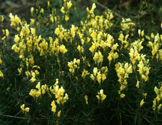Home - View all weeds - Photo Key - Credits
YELLOW TOADFLAX
Linaria vulgaris
Family: Snapdragon Family (Scrophulariaceae)
Other Names: bread-and-butter, brideweed, butter-and-eggs, buttered haycocks, calve's snout, churnstaff, common linaria, common toadflax, continental flower, dead man's bones, devil's flax, devil's flower, devil's head, devil's ribbon, doggies, dragon bushes, eggs-and-bacon, eggs-and-collops, flaxweed, fluellin, gallwort, impudent lawyer, Jacob's ladder, larkspur, lion's mouth, monkey flower, patten and clogs, pedler's basket, rabbit-flower, rabbit's weed, ramstead, ranstead, toad, wild flax, wild snapdragon, wild tobacco, yellow rod, yellow toadflax.
Origin and Distribution: Toadflax is a native of Eurasia that was introduced into North America as a garden flower despite warnings of its weedy potential. Because it was regarded as a desirable wild flower, it was allowed to escape cultivation and spread. As a result, it is now naturalized throughout the U.S. and Canada. Toadflax is commonly found in eastern North America and along the Pacific Coast. It is distributed throughout Ohio. It can be found along roadsides, fence lines, waste places, pastures, rangeland, wood edges, and in cultivated fields. Reproduction is by seeds and creeping horizontal roots. The species is very adaptable and can be found growing in a wide range of conditions from sub-arctic to temperate, dry plateaus to damp rocks, mountain regions to grazed areas, and gravelly or sandy soils to fertile loams.
Plant Description: Toadflax is a perennial with erect, smooth, herbaceous stems that are less than 2 feet tall and emerge in clumps from a spreading root system. Soft, gray-green leaves, which are 1 to 1 1/2 inches long and narrow, are crowded onto each stem. Stems terminate with clusters of 15 to 20 snapdragon-like flowers that are about 1 inch long and yellow. Gently pinching the sides of a flower opens its 2 lips revealing an orange throat that acts as a guide for insects to nectar produced in the spur. The plant reproduces by seeds and creeping roots.
- Root system - The root system consists of horizontal spreading roots and secondary fibrous roots.
- Seedlings & Shoots - Young leaves are pale green with a powdery bloom, especially beneath. First true leaves are egg-shaped and the leaves that follow get progressively longer and more linear. Even in young plants, horizontal creeping roots form at the soil surface.
- Stems - Stems are erect, leafy, 1 to 2 feet tall, and either hairless or sparsely hairy at the top. Stems may be branched, especially at the top. Multiple stems emerge from the same root system.
- Leaves - Leaves are narrow, linear, soft, gray-green, and less than 1 1/2 inches long. Leaves are so densely crowded on the stem that they appear opposite (2 leaves per node) although they are alternate (1 leaf per node). Leaves taper at the base and attach directly to the stem.
- Flowers - Flowers consist of 5 united petals forming a 2-lobed upper lip and a lower lip with 3 lobes that end in a long spur. Petals are yellow with an orange palate on the lower lip. Flowers look snapdragon-like and are about 1 inch long. Flowers are located at the top of stems in dense clusters of between 15 to 20.
- Fruits & Seeds - Fruits are egg-shaped, 2-celled capsules filled with many blackish, disk-shaped, winged seeds. When dry, pores at the apex of each capsule open releasing seeds.
Similar Species: Dalmatian toadflax (Linaria dalmatica) is a related species that is more prevalent in the western portion of North America while toadflax is more common in the east. Compared with toadflax, dalmatian toadflax is taller, more branched, and has broader leaves with rounded bases that clasp the stem. Also, its seeds are sharply angular rather than round and flat.
Biology: Toadflax flowers from June to August. Seeds are shed from July until frost. Most seeds fall near the parent plant, although seeds have broad wings making wind dispersal possible. Other agents of dispersal include water, insects, and animals. Toadflax reproduces by creeping roots, which results in clumps of individuals sharing the same root system. The plant can usually be controlled by intensive cultivation. Herbicides are also effective, especially if applied when flowering begins in summer. Populations resistant to some herbicides have been reported. Therefore, herbicides should not be used as a sole long-term agent of control. Biological control programs are currently being studied that use insect predators of flowers, fruits, and seeds.
Toxicity: None known.
Facts and Folklore:
- 'Linaria' was derived from the Latin 'linon' or 'linum', which means flax, because the foliage looks similar to that of flax.
- 'Toadflax' refers to the resemblance of the flowers to toads and the foliage to flax.
- 'Butter-and-eggs' refers to the yellow and orange color of the flowers.
- Toadflax has been used medicinally to treat various ailments. Teas and lotions made from the foliage were used to treat such complaints as constipation, jaundice, insect bites, and throat problems.
- Toadflax was widely used to make yellow dye.
- According to Scottish superstition, walking around toadflax 3 times will unbind any spell, and the English believed that 3 toadflax seeds strung on linen thread would ward off evil.










